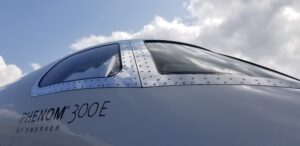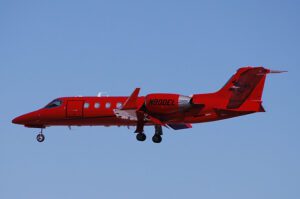
Light Jets and Lear, are they all a thing of the past? Maybe. We will take a look this week at three light jet options for the private jet charter flyer. We can’t begin to discuss this category without talking about Learjet first. For many of us, our first introduction into the world of private jet charter flights were on a Lear. They were one of the first companies to manufacture a private luxury aircraft. They were fast and sleek in design and the Learjet 23 burst onto the private travel scene in the early 60s. After numerous changes in ownership, Learjet has been a subsidiary of Bombardier Aerospace since the early 90s. They gave it their best shot with the Learjet 60 and the 45, but announced in February of 2021 that they would end production of the newest Learjet 75 and the rest of the lineup. In my opinion it is the result of a trend towards moving to larger craft with better range, more seating, ample luggage storage, and increased fuel capacities. Bombardier sited their intention back in 2021 to focus on its larger Challenger and Global Jets. These larger aircraft better meet the growing expectations of the wealthier private jet traveler. For now Bombardier remains committed to fully support the Learjet fleet well into the future, but we are already hearing some complaints from the fleet of about 2000 Lear’s still in service regarding delays in performing necessary annual inspections and other required services. Let’s take a look at a remaining Learjet in the light Jet category and hope it will continue to be a viable option for the private jet flyers needing a short, economical flight to meet their needs.
Learjet 31a – Light Jets
This is the extended range version of the original Learjet 31. It’s a late 90s era, seven passenger light jet. As with most Lears it is very fast, and can cruise at 845km/h or 456 kts. It has a flight altitude in between 45,000 and 47,000 ft. The 31a has two rear-mounted turbofan engines produced by Honeywell. The TFE73131-2s are fitted with a digital electronic engine control system, an engine synchronizer and a Dee Howard thrust reverser. The aircraft has conventional and manual controls, and include Honeywell digital avionics with the five-tube electrical flight instrumentation system. The jet can be flown fully by hand or by using the KFC 3100 flight control system, a dual digital three-axis autopilot. The typical layout includes room for both crew members and four passengers. The cabin is fitted with a club-style divan and four Erda Adjustable seats with folding tables. Cabin width is about 4.9 feet and the height is roughly 4.26′ which is very typical of the sleek fuselage design of the Lear. It has a maximum range of 1,455 nm. The normal baggage capacity is 1.13 cubic meters and an external baggage locker might be included that increases total capacity to 1.47 cubic meters. You can typically find a Lear 31a at an Hourly rate around $2,900* USD per hour. Its a great small jet for a quick hop or an added leg to a bigger mission.
Cessna CJ4
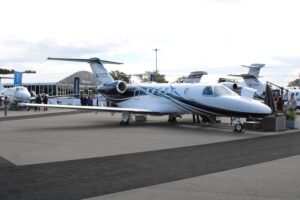
The Cessna CJ4 is a beautiful light jet. The first CJ4 was delivered in 2010 after a rigorous flight-test of 1,000 sorties and more than 1,600 hours in the air since its first flight in 2008. It has a 17,110 lb max take-off weight and is a big light jet with typical passenger seating for 7. It looks good because it has the slick wing geometry from the Citation Sovereign and the big Citation Mustang passenger doors. It has the powerful Williams FJ44-4A engines helping it cruise along at a fast 454 kts. Flying at 43,000 feet is a quick launch from takeoff and the overall range is 1,667 nautical miles. In the cockpit both pilots enjoy increased legroom in a great ergonomic layout. The avionics are the four-display Rockwell Collins Pro Line 21 with the latest safety enhancements, including electronic charts, graphical weather uplink, terrain avoidance and anti collision systems. In the cabin, passenger can enjoy the Rockwell Collins Venue cabin-management system, switch panels at each seat position, and power outlets for laptops or cell chargers. There is much more legroom for the passengers than you find in the shorter fuselage CJ3s. The floor in the CJ4 is lowered to provide a wider cabin and better viewing out of the windows. And finally in a light jet, the aft lavatory features a left-handed belted potty with a small vanity. The cabin width is 5 ft as is the height. You will find the average charter rates at about $3,100* USD per hour.
Phenom 300e
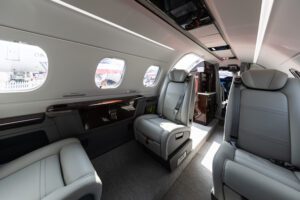
The first time I had a chance to tour and see this beautiful light jet offering from Embraer executive Jets was at the EAA AirVenture back in 2019. It is pretty much the best-selling light jet in the world and deservingly so. This jet is FAST, capable of speeds up to Mach 0.80 with a ridiculously quiet cabin space. It has a notable safety feature found only in this business aircraft: the runway overrun awareness and alerting system (ROAAS), which provides a warning if the runway approach is too steep or too fast. The jet is a twin-engine cantilever monoplane with low-positioned, swept wings. It has two Pratt & Whitney Canada PW535E turbofan engines. The NBAA 4 PAX IFR Range is 1,971 NM with a flight altitude of 45,000 ft. The maximum cruise speed is 453 kts with a max take off weight of 18,387 lbs. The enclosed cabin has room for 9 passengers and a two-pilot crew. The aircraft is installed with advanced Prodigy Touch flight deck based on the Garmin 3000 avionics suite. The flight deck features three 14.1″ interchangeable displays with soft keys. The cabin is typically found in the six passenger standard configuration with seating that has an extendable comfy headrest along with bolsters, retractable armrest, broad seatbacks, and extendable leg rests. The cabin is also installed with HD by Lufthansa Technik, a state-of-the-art cabin control system which supports the integration of portable devices and enables wireless audio and video streaming. The cabin width is 5′ 1″ and the height is 4′ 11″. To charter the fast Phenom 300e you will pay about $3,350* USD per hour.
Referencing the light jet private travel category – “With each passing decade the needs changed, Mark Masluch, Bombardier’s director of communications, told the Robb Report in an April 21st, 2022 article. “First it was city-to-city, then it became coast-to-coast, then trans-Atlantic, then trans-Pacific. People used to enter the market with a light jet and work their way up, but now, with the range needs and the amount of wealth creation, they go right to a mid-size or even a $60 million global jet.” Light jets are far less profitable than their bigger siblings in the mid to heavy jet categories putting additional pressure on the production of future light jets. Next week we look at three reasons in the mid-sized jet category making our customers say “go big or stay home. “
Until then, Be Social, Fly Private! Sign Up Today! Follow us on Instagram Follow us on Facebook
*These are base hourly rates per craft type with no ferry times, FET taxes, taxi time, or fuel surcharges. Typical final hourly rates will be higher based on category and timing.

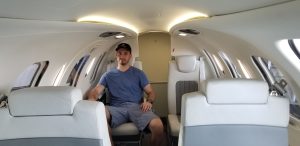 Size matters when its a private jet charter. Luckily there are a lot of jet sizes to choose from when it comes to selecting your charter. They start in the category of very light jet all the way to a Boeing Business Jet that is the size of a commercial airliner. Today we will take a look at the entry level of the 4 categories in the air charter world, the very light jets. Since there are many in this category, we will discuss 3 of the hotter very light jets. It really comes down to what the mission is and how many people will be aboard. It also can have a lot to do with who will be flying. Sometimes the CEO will need his or her own space away from the travel group, and then only certain jets will do. Or the trip is for a large group and the seating capacity will be the main priority. Cargo space may be a deciding factor for a golfing weekend or a fashionista with an entourage of luggage. There are also various cruise speeds and the range flown without a fuel stop to consider. All in all, the process of choosing the right jet for a charter can be simple or at times very complex, especially on a multi-leg tour. Let’s look at the Very Lights this week.
Size matters when its a private jet charter. Luckily there are a lot of jet sizes to choose from when it comes to selecting your charter. They start in the category of very light jet all the way to a Boeing Business Jet that is the size of a commercial airliner. Today we will take a look at the entry level of the 4 categories in the air charter world, the very light jets. Since there are many in this category, we will discuss 3 of the hotter very light jets. It really comes down to what the mission is and how many people will be aboard. It also can have a lot to do with who will be flying. Sometimes the CEO will need his or her own space away from the travel group, and then only certain jets will do. Or the trip is for a large group and the seating capacity will be the main priority. Cargo space may be a deciding factor for a golfing weekend or a fashionista with an entourage of luggage. There are also various cruise speeds and the range flown without a fuel stop to consider. All in all, the process of choosing the right jet for a charter can be simple or at times very complex, especially on a multi-leg tour. Let’s look at the Very Lights this week.
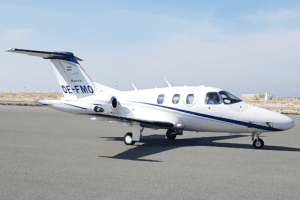
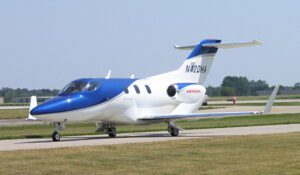
 The 50 hour guideline for flying private.
The 50 hour guideline for flying private.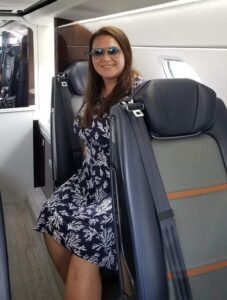 Private air charter has many challenges ahead. Pictured above is one of our Managing Partners, Katherine Koch, my darling wife and future commercial ATP pilot. Unfortunately she only represents a small number of future commercial pilots headed towards the private air charter industry or a major commercial airlines. The pilot shortage is private aviation’s number one challenge, further exacerbated by competition for pilots from airline and freight operations. The airlines are offering huge sign-on bonuses, great work schedules, amazing benefits packages, and lofty annual salaries particularly for anyone experienced enough to graduate to the left seat of these jets. After forcing early retirements during the pandemic, the majors are desperately playing catch-up in this highly competitive industry. Upward mobility was already accelerated before the pandemic but now in the aftermath pilots are upgrading at minimums and jumping from regional to major airlines with unprecedented speed. There is a huge presence in aviation schools by most of the regional airlines that feed these major carriers, something we are not seeing enough of by the private air charter industry. It is a major challenge among many others we will discuss further in this article. In this article, we will take a quick look back 5 years ago at the challenges to private air charter that have shaped the current industry. In next week’s post, we will take a deeper dive into the current private air charter industry.
Private air charter has many challenges ahead. Pictured above is one of our Managing Partners, Katherine Koch, my darling wife and future commercial ATP pilot. Unfortunately she only represents a small number of future commercial pilots headed towards the private air charter industry or a major commercial airlines. The pilot shortage is private aviation’s number one challenge, further exacerbated by competition for pilots from airline and freight operations. The airlines are offering huge sign-on bonuses, great work schedules, amazing benefits packages, and lofty annual salaries particularly for anyone experienced enough to graduate to the left seat of these jets. After forcing early retirements during the pandemic, the majors are desperately playing catch-up in this highly competitive industry. Upward mobility was already accelerated before the pandemic but now in the aftermath pilots are upgrading at minimums and jumping from regional to major airlines with unprecedented speed. There is a huge presence in aviation schools by most of the regional airlines that feed these major carriers, something we are not seeing enough of by the private air charter industry. It is a major challenge among many others we will discuss further in this article. In this article, we will take a quick look back 5 years ago at the challenges to private air charter that have shaped the current industry. In next week’s post, we will take a deeper dive into the current private air charter industry.